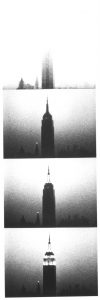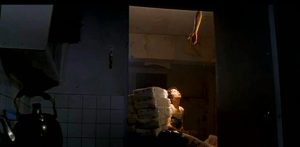Architects of Time: Reel Images from Warhol To Tsai Ming-Liang brings me to the new realm of film and architecture, seeing filmatic architecture with new eyes.
One may feel confused why architecture is a film. But after watching Andy Warhol’s Empire (1964), I am convinced that architecture is indeed a film. The reflective quality of Empire’s facade becomes a large screen where an urban film displays. The building plays the changing of time with diffraction. The light texture of architecture enables high sensitivity to the “atmosphere”, hence architecture becomes a “pure atmosphere” and a film. However, one not only feels the texture but also experiences “the expanse of geological time”. As architecture inhabits in cities over time, like an old man who went through all the historical milestones, the human history is in the eyes of architecture. It is up to the viewers to decide what genre of film architecture is.

Diving into Warhol’s world and exploring the nature of film, Bruno raises the idea of “zero degree of film” – a “reproduction of real” through observation. The discussion of whether pure observation is a film may be controversial but at the same time profound and insightful. Even I am not really into the study of film, I am quite allured to this compelling conversation. Interweaving with the idea of temps mort, the non-action in the “zero degree” reel time of Empire empowers “space to tell its story” instead of the actors. Such a space creates leftovers of time where viewers can linger in through watching an “architecture everyday”. This space also offers qualities for meditations.
The connection between architectural space and mental space in Empire is reinforced by Tsai Ming -Liang’s films. In Hole (1998), two main characters start a connection because of the hole in the ceiling/ floor. The hole touches their loneliness and connects them. The literal opening in architectural space (hole) becomes an opening in the mental space to connect another soul. From a broader perspective, Antonioni points out that“rhythm of the city coincides with a person’s own internal clock”. This connection shares resemblance to the concept of correspondence in literature – parallels between the external world and the soul. The city and the mind are mutually influencing each other. In this case, architecture and “the architecture of interiors” are interconnected in the reel time through the film.

There is also a connection between space and time apart from connections between spaces. In my opinion, Bruno subtlety emphasises on the “spatio-temporal connections”. Just as the space creates leftovers of time; time calls in mental space. Space and time mutually exist. I start to be enchanted by the spatio-temporal reel where I subside.
By Mak Sum Yuet Faustine (UID:3035486772)